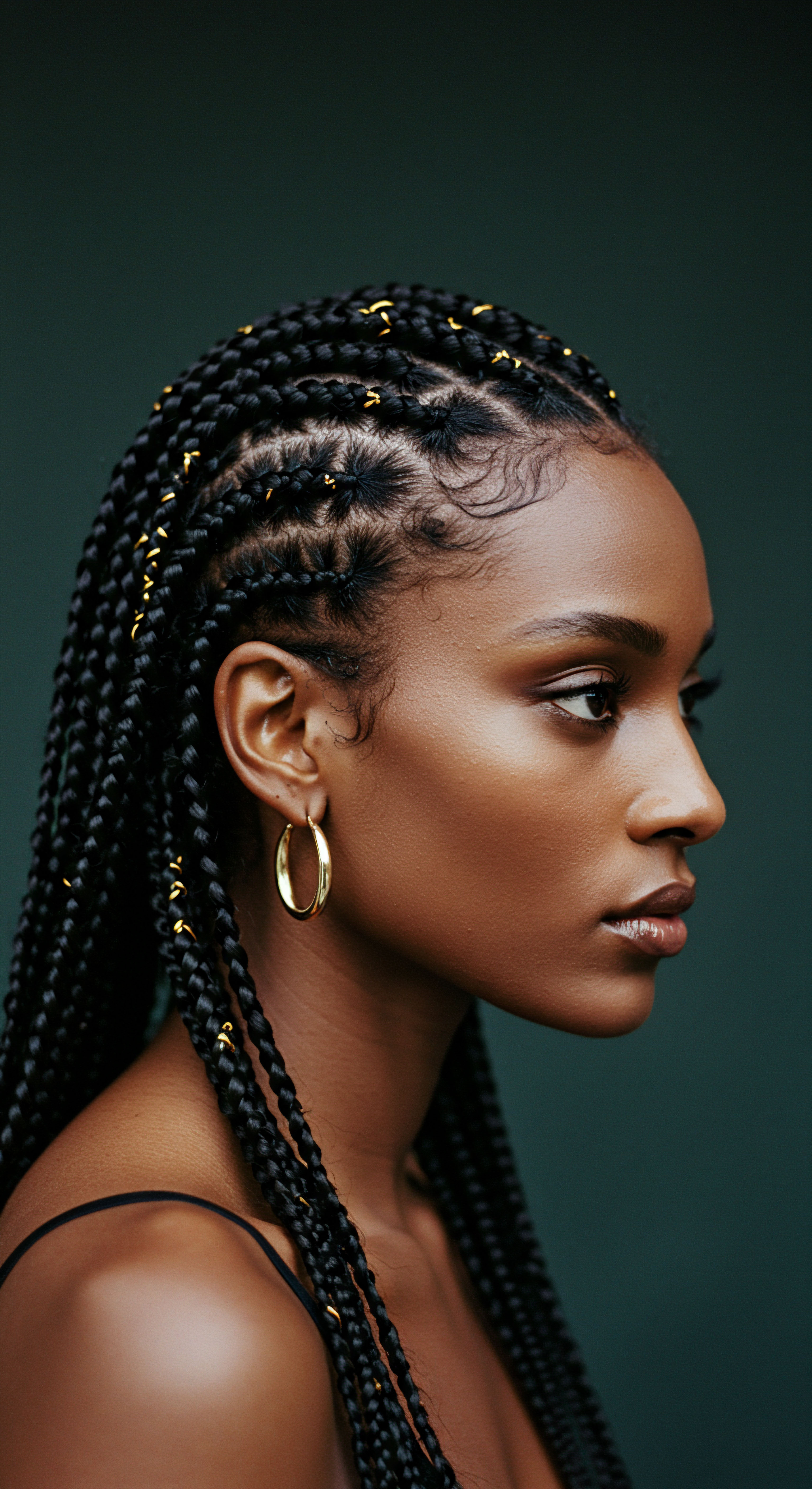
Roots
The quiet moments before slumber, when the day’s burdens begin to recede, have long held a special significance for those with textured hair. It is a time when the delicate coils and curls, often resilient yet vulnerable, seek respite from the world’s constant touch. The question of how historical tools shielded textured hair at night is not merely an inquiry into ancient artifacts; it is an invitation to witness the enduring wisdom of generations, a gentle unfolding of practices born from necessity and a deep understanding of hair’s inherent nature. This exploration takes us beyond simple coverings, revealing a heritage of thoughtful care that speaks to the very essence of protection.

Ancient Origins of Hair Preservation
Across diverse civilizations, the recognition of hair’s fragility, particularly hair with a tighter curl pattern, led to ingenious solutions for its nightly preservation. From the arid plains of ancient Egypt to the vibrant communities of West Africa, people intuitively grasped the importance of minimizing friction and maintaining moisture during rest. These early practices were not just about aesthetics; they were about sustaining hair health, preventing tangles, and preserving the intricate styles that often carried profound cultural or social meanings.
Consider the daily rhythms of ancient life, where exposure to elements like dust, sun, and wind was constant. Night offered a sanctuary, a chance for hair to recover. Early materials, often readily available, were repurposed for this vital role.
Animal skins, carefully softened, or plant fibers woven into rudimentary caps provided a first line of defense. The choice of material, though seemingly simple, often reflected an intuitive understanding of properties that would reduce snagging and absorb less moisture from the hair itself.
The historical shielding of textured hair at night stems from ancient, intuitive practices focused on minimizing friction and preserving moisture.
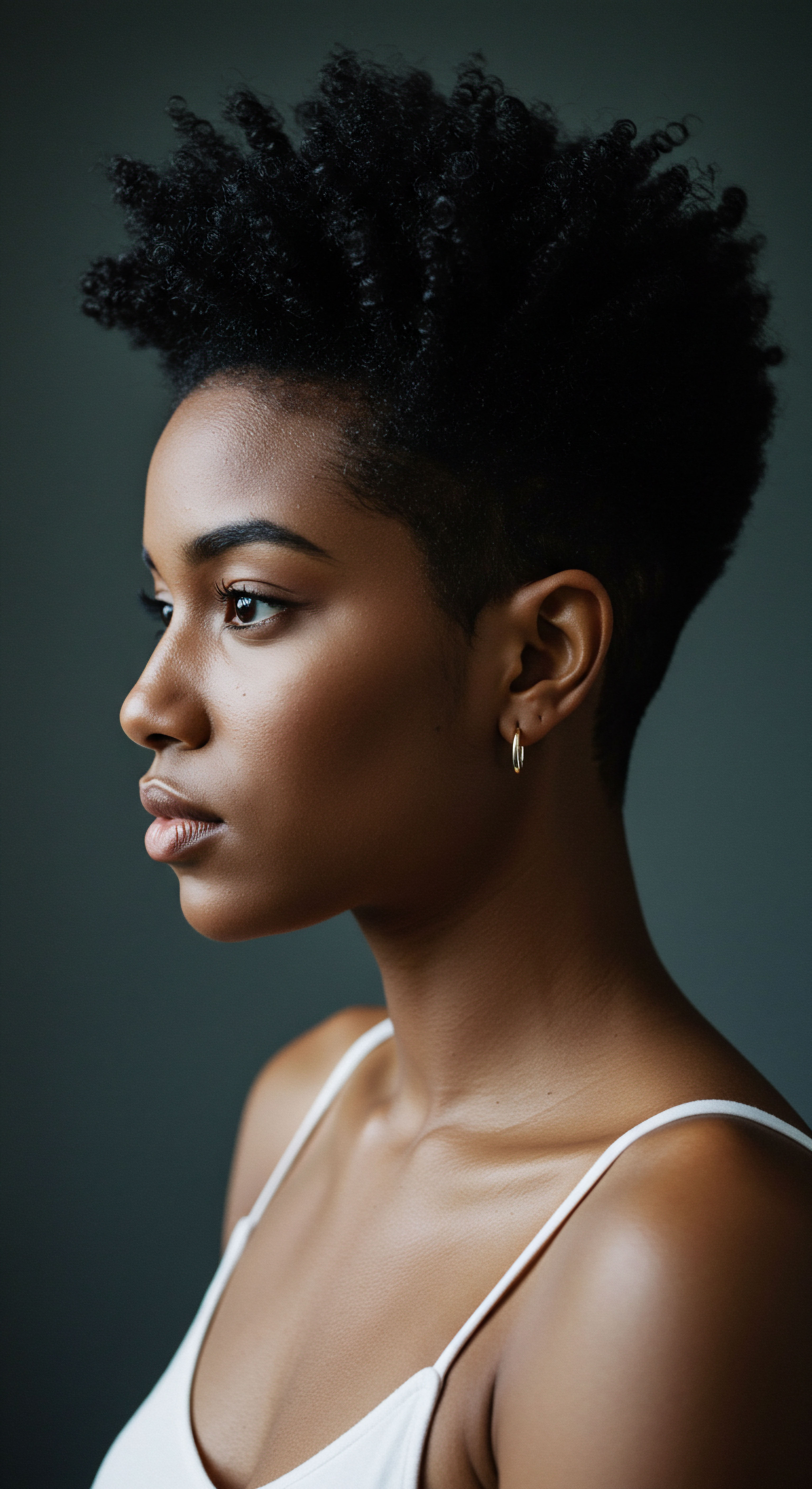
The Purposeful Veil
The concept of covering the head for protection is as old as humanity itself. For textured hair, this practice held an additional layer of purpose. It was a strategic act to guard against the abrasive surfaces of sleeping arrangements, whether rough sleeping mats, early pillows stuffed with coarse materials, or even the bare ground.
The simple act of wrapping or covering the hair could significantly reduce mechanical stress that might otherwise lead to breakage and matting. This protective instinct laid the groundwork for more refined tools and rituals that would follow.

Early Materials and Their Qualities
The materials chosen for early nighttime hair protection were a testament to resourcefulness. While luxury fabrics like silk would come much later, communities utilized what was at hand.
- Softened Hides ❉ Animal skins, processed to be supple, could offer a smooth surface.
- Woven Plant Fibers ❉ Certain plant fibers, when finely processed and woven, provided a breathable yet protective layer.
- Early Cottons ❉ As cotton cultivation spread, softer, woven cotton cloths would have provided a more accessible option, though their absorbency was a known challenge for moisture retention.
These rudimentary tools, while simple, were the forerunners of the more sophisticated head coverings and hair preparation techniques that would become hallmarks of textured hair care. They underscore a universal recognition of hair’s delicate nature and the need for mindful protection during the hours of rest.

Ritual
Stepping from the foundational insights of early hair preservation, we arrive at the deliberate and often cherished practices that transformed simple acts into meaningful rituals for textured hair at night. This realm of practice speaks to a deeper connection with hair, moving beyond mere functionality to embrace a sense of mindful care. It is here that the tools gain their true significance, not just as objects, but as instruments within a thoughtful, nightly cadence. The guidance here is gentle, inviting an understanding of how these historical methods shaped daily life and hair health.
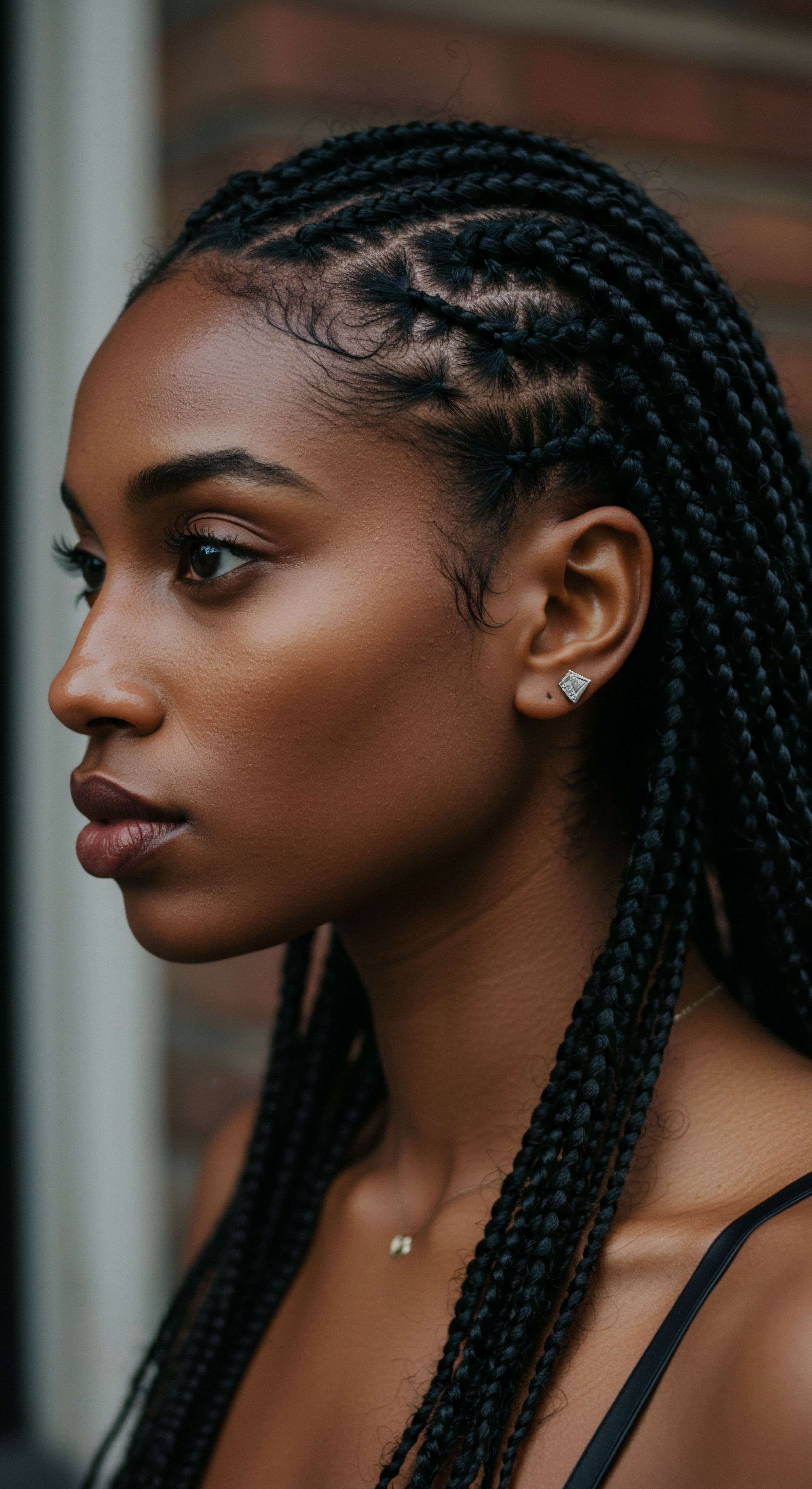
The Art of the Headwrap
Headwraps, or head ties, represent one of the most enduring and culturally rich tools for protecting textured hair at night. Their presence spans continents and centuries, each region imparting its unique style and meaning. Beyond their aesthetic appeal, headwraps served a pragmatic purpose ❉ to keep hair contained, reduce friction against sleeping surfaces, and maintain moisture.
In many African cultures, these coverings were not just for night; they were worn daily, symbolizing social status, marital status, or even tribal affiliation. The shift to wearing them at night was a natural extension of their protective function, safeguarding elaborate daytime styles or preparing hair for the coming day.
Headwraps, a timeless cultural tool, offered protection and retained moisture for textured hair during sleep.
Consider the careful folding and tying of a cloth, often of smooth, tightly woven material. This technique, passed down through generations, created a cocoon for the hair, minimizing tangling and breakage that could occur from restless sleep. The smooth inner surface, whether from a specific fabric choice or the way the cloth was folded, was paramount in preserving the hair’s cuticle layer.

Bonnets Through the Ages
The bonnet, in its various forms, also holds a significant place in the history of nighttime hair protection. From simpler designs in Colonial America, often made of cotton or wool for sun and wind protection, to more refined versions in Europe using luxurious fabrics, bonnets evolved to serve both practical and symbolic roles. For textured hair, the bonnet became a specialized tool.
During the period of slavery in America, African American women used headwraps and bonnets to shield their hair from harsh conditions, making them a symbol of resilience. These coverings provided a crucial barrier against the friction of rough bedding, helping to preserve hair health and maintain moisture in a time when access to proper hair care was severely limited.
The evolution of the bonnet reflects a growing understanding of hair’s needs. While early versions might have been simpler, the intent remained consistent ❉ to encase the hair gently, allowing it to rest undisturbed. The shift towards materials like silk and satin in later periods was a testament to recognizing their superior qualities for hair preservation, reducing friction and aiding moisture retention.

How Did Braids Become a Nighttime Shield?
Braiding, twisting, and cornrowing were not solely daytime styles; they were also fundamental nighttime protective measures. This practice, dating back thousands of years in African cultures, provided a structured way to secure hair, preventing it from tangling, snagging, and suffering mechanical damage during sleep. The act of sectioning and braiding hair before bed created organized, compact units that were less prone to friction than loose hair.
In many communities, this nightly braiding ritual was a communal activity, a time for sharing stories and strengthening bonds. It was a practical solution that offered multiple benefits:
- Reduced Friction ❉ Braids kept hair contained, minimizing rubbing against pillows.
- Prevented Tangles ❉ Hair strands were organized, making morning detangling easier and reducing breakage.
- Maintained Style Integrity ❉ For those with daytime protective styles, re-braiding or securing them at night helped extend their life.
- Aided Moisture Retention ❉ When combined with oils or butters, braiding helped seal in hydration.
The simplicity of braiding, combined with its profound protective qualities, made it a cornerstone of historical nighttime hair care for textured hair.
Here is a table outlining some common historical tools and their primary protective functions:
| Tool Headwraps / Head Ties |
| Primary Materials Woven plant fibers, cotton, later silk/satin |
| Key Protective Function Reduces friction, contains hair, maintains moisture, cultural symbolism |
| Tool Bonnets |
| Primary Materials Cotton, wool, later silk/satin |
| Key Protective Function Encases hair, prevents friction, preserves styles, maintains moisture |
| Tool Braids / Twists |
| Primary Materials Hair itself, sometimes with added fibers |
| Key Protective Function Minimizes tangling, reduces mechanical stress, organizes strands |
| Tool Sleeping Mats / Pillows |
| Primary Materials Natural fibers, smooth plant leaves, animal skins |
| Key Protective Function Reduces friction between hair and sleeping surface |
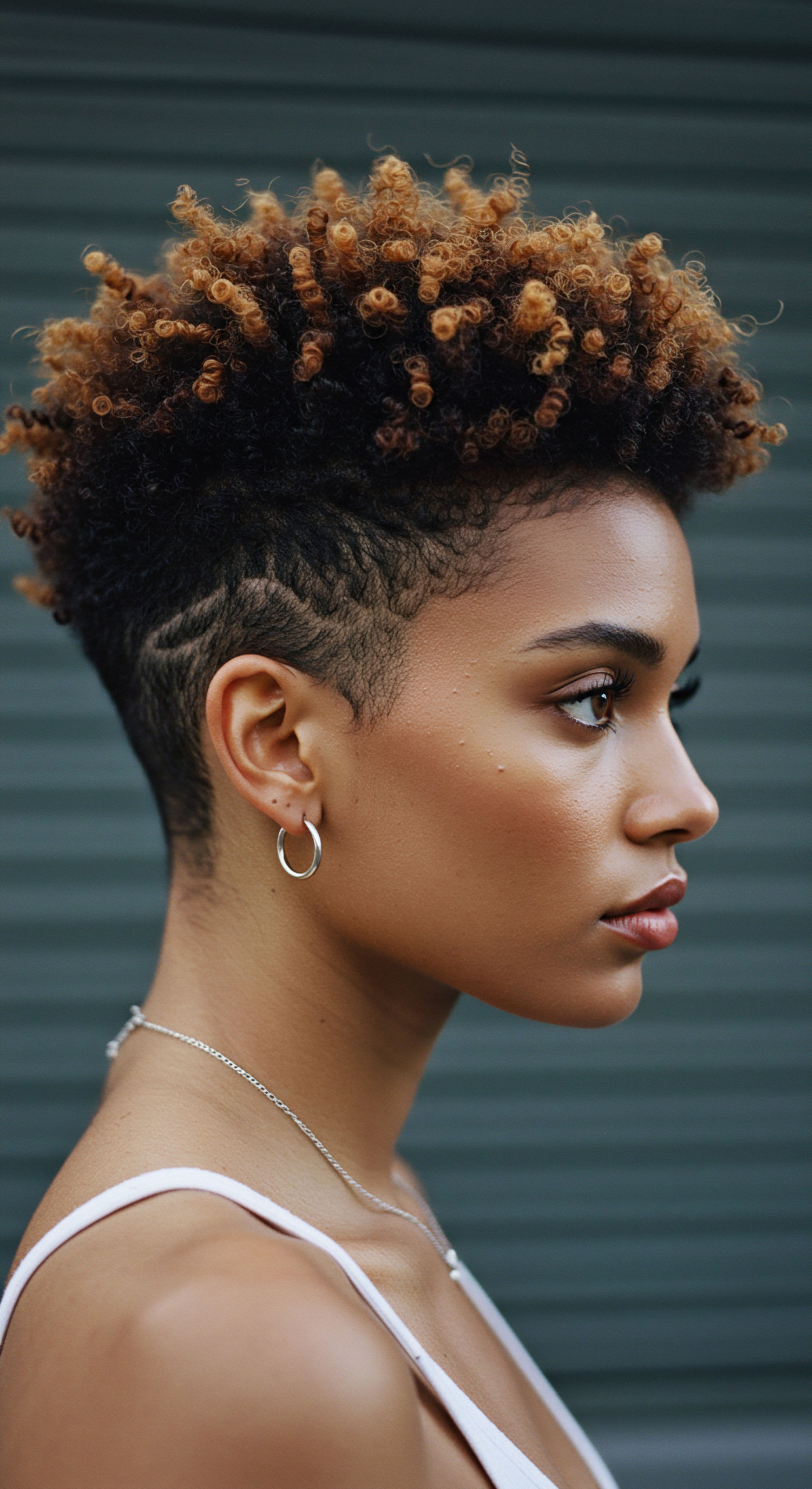
Relay
As we delve deeper into the safeguarding of textured hair during sleep, the conversation broadens beyond mere implements to encompass the intricate interplay of science, culture, and enduring practices. How did ancestral knowledge about materials and techniques anticipate modern scientific understanding of hair’s vulnerability? This exploration invites us to consider the profound wisdom embedded in historical routines, recognizing them not as quaint customs, but as sophisticated, multi-dimensional solutions for preserving hair’s delicate architecture.

The Science of Gentle Rest
The protective qualities of historical nighttime tools for textured hair find compelling resonance in contemporary trichology. Textured hair, characterized by its unique helical structure, possesses more points of curvature along its length, making it inherently more susceptible to mechanical damage from friction and manipulation. Each bend in a curl represents a potential weak point where the cuticle, the hair’s outermost protective layer, can lift, chip, or break when rubbed against rough surfaces.
When we sleep, our hair is in constant contact with bedding. Traditional cotton pillowcases, with their coarser fibers, create significant friction. This friction can lead to cuticle damage, moisture loss, tangling, and ultimately, breakage. The smooth, tightly woven materials historically chosen for head coverings—like silk or finely processed plant fibers—acted as a gentle barrier.
Silk, in particular, boasts a lower coefficient of friction compared to cotton, allowing hair to glide over its surface rather than snagging or creating abrasive forces. This reduction in friction is crucial for preserving the integrity of the hair shaft and minimizing the mechanical stress that contributes to hair loss and thinning over time.
Historical hair coverings intuitively addressed textured hair’s vulnerability by minimizing friction and preserving moisture.
A study investigating the friction coefficient of various textiles against human hair, for example, highlights the significant difference between materials. Research has shown that polyester and nylon headscarf textiles exhibit lower friction values when sliding against hair compared to cotton. While these specific studies might use modern materials, the underlying principle holds true for historical smooth textiles ❉ less friction equals less damage. This scientific understanding validates the intuitive choices made by ancestors who recognized the need for smooth surfaces to protect their hair during rest.
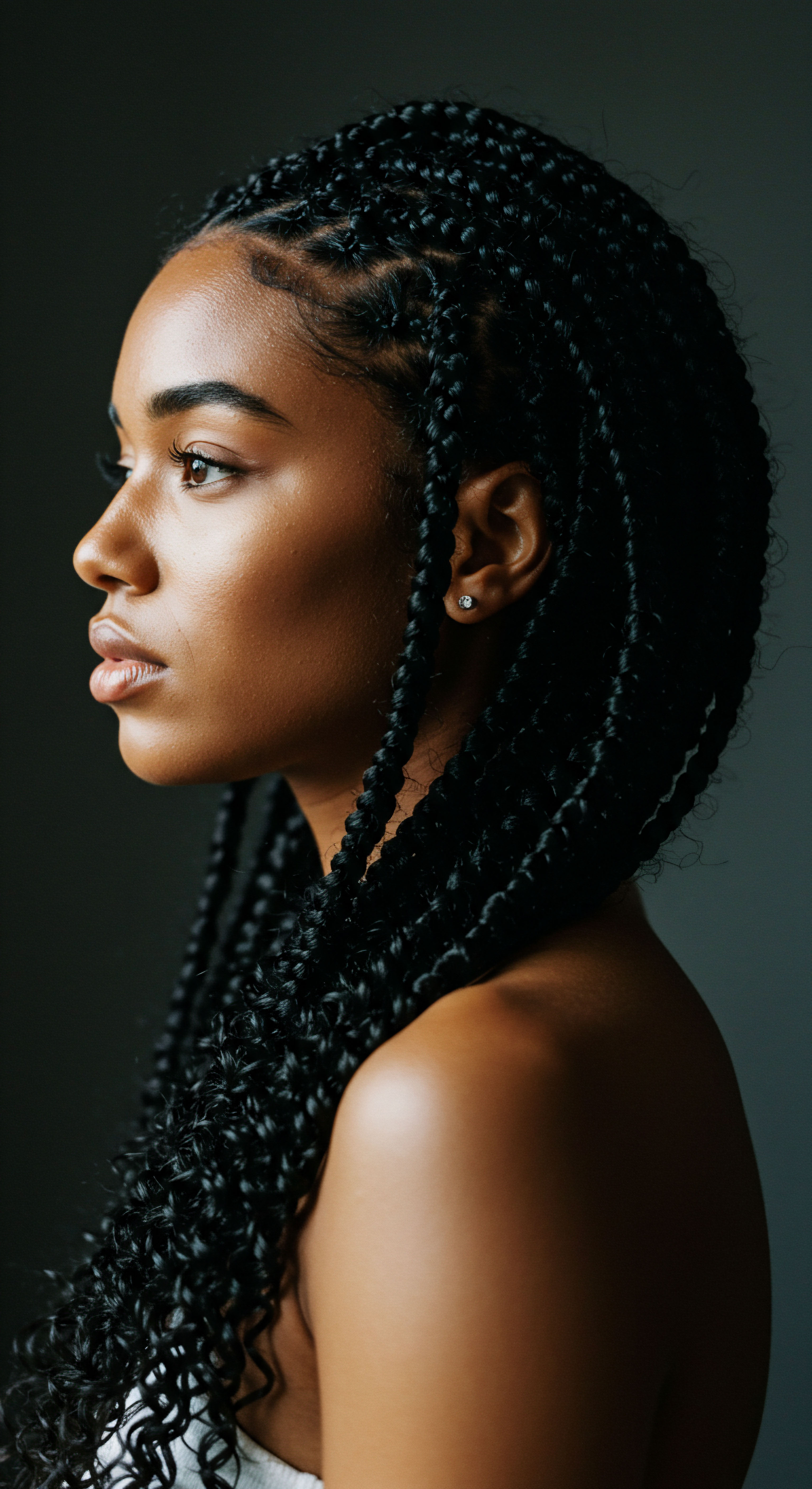
Cultural Resonance of Covered Strands
Beyond the biophysical advantages, the act of covering textured hair at night was deeply intertwined with cultural identity, self-care, and even resistance. In many African societies, hair was, and remains, a powerful symbol of heritage, spirituality, and social standing. Protecting hair was thus a way of honoring oneself and one’s lineage.
During the transatlantic slave trade, when enslaved Africans were often forced to shave their heads as a means of dehumanization and cultural erasure, the re-adoption of head coverings and protective styles became acts of quiet defiance and cultural preservation. These nighttime rituals, often performed in secret or within the intimate circle of family, served as moments of connection to a heritage that colonizers sought to dismantle. The headwrap, the bonnet, and the meticulously braided style became silent testimonies to an unbroken spirit and a commitment to ancestral ways.
This cultural dimension underscores that the tools were not merely functional objects; they were vessels of meaning, passed down through generations, embodying wisdom, care, and resilience. The continuity of these practices, even in the face of immense adversity, speaks volumes about their profound significance.
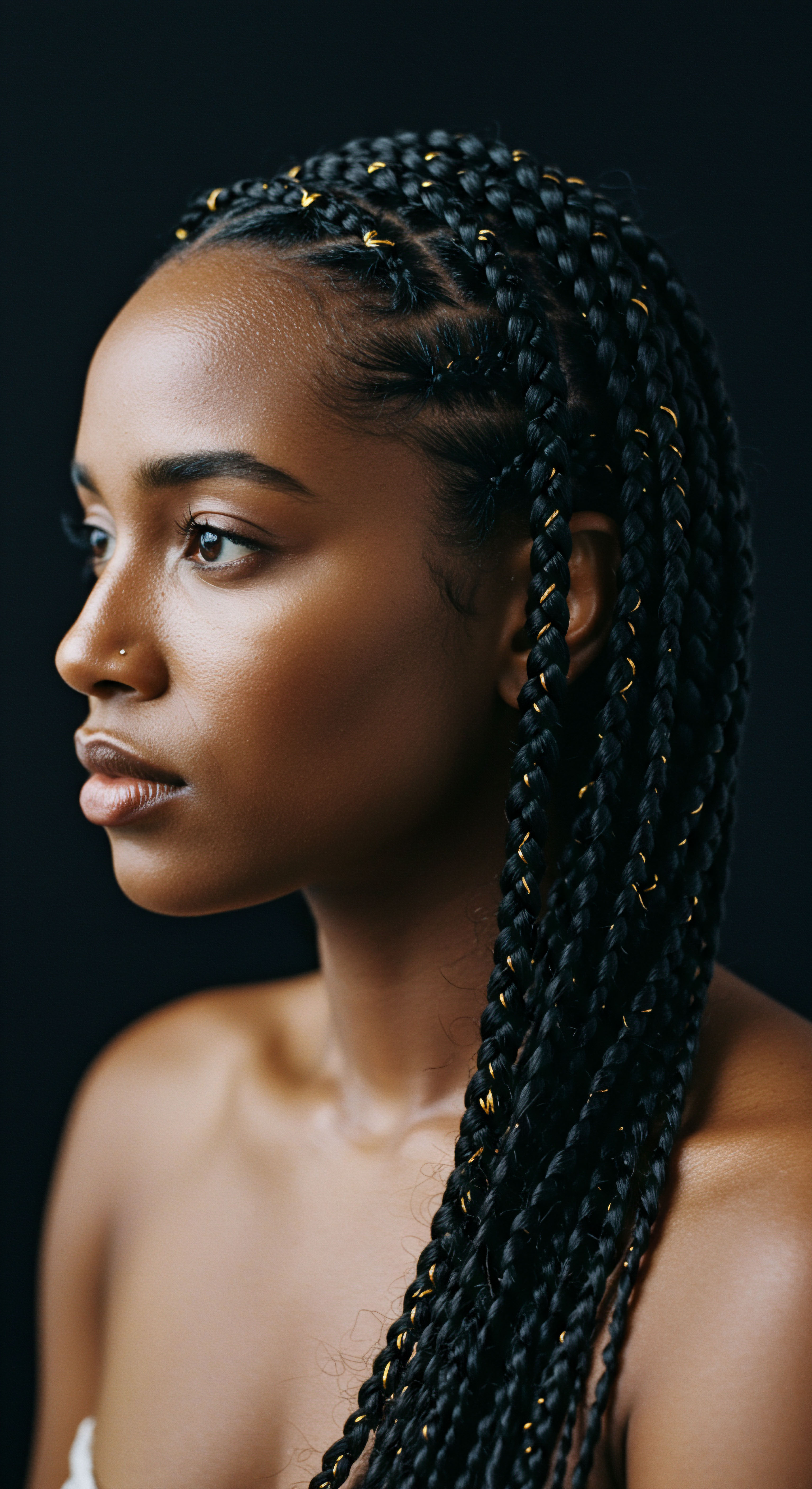
Did Nighttime Hair Practices Reflect Social Standing?
In some historical contexts, the materials and styles used for nighttime hair protection could indeed reflect social standing. While basic protection was universal, access to more luxurious materials like fine silk or intricately embroidered coverings would have been reserved for the elite. For instance, in ancient Egypt, elaborate wigs, sometimes covered with cloth, were symbols of wealth and status, and their preservation at night would have been a priority. Similarly, in certain African cultures, the quality of head wraps or the complexity of braided styles could denote an individual’s wealth or position within the community.
However, it is important to acknowledge that the fundamental act of protecting hair at night transcended social strata. Even those with limited resources found ingenious ways to shield their strands, often using simpler, locally sourced materials. The core purpose—preserving hair health—remained consistent, regardless of one’s economic standing.

A Statistical Glimpse into Hair Integrity
The wisdom of historical protective measures gains further clarity when viewed through the lens of modern hair science. Textured hair is particularly susceptible to mechanical damage due to its unique structure. Studies on hair breakage reveal that Afro-textured hair can break roughly ten times faster than straighter Caucasian hair when subjected to the same shear stresses from combing or brushing. This inherent fragility makes nighttime protection against friction all the more critical.
Consider the comparative friction between different fabrics and hair. Research on the coefficient of friction, which quantifies the resistance to motion between two surfaces, consistently shows that smooth materials like silk or satin create significantly less friction against hair fibers than rougher materials like cotton. While specific historical data on fabric friction against hair is scarce, contemporary studies confirm the benefits. For example, a study comparing the friction coefficient of various headscarf textiles against human hair found that cotton exhibited higher friction values compared to polyester and nylon, particularly at lighter loads.
This suggests that ancestral choices of smooth, tightly woven materials, even if not silk, would have provided a measurable advantage in reducing mechanical stress on textured hair during sleep, directly mitigating the accelerated breakage rates observed in scientific studies of textured hair under friction. The daily ritual of securing hair in smooth coverings was, therefore, an empirical solution to a biophysical vulnerability, passed down through generations.
This deeper understanding of historical tools reveals a sophisticated, interconnected system of care, rooted in both practical observation and a profound cultural connection to hair.
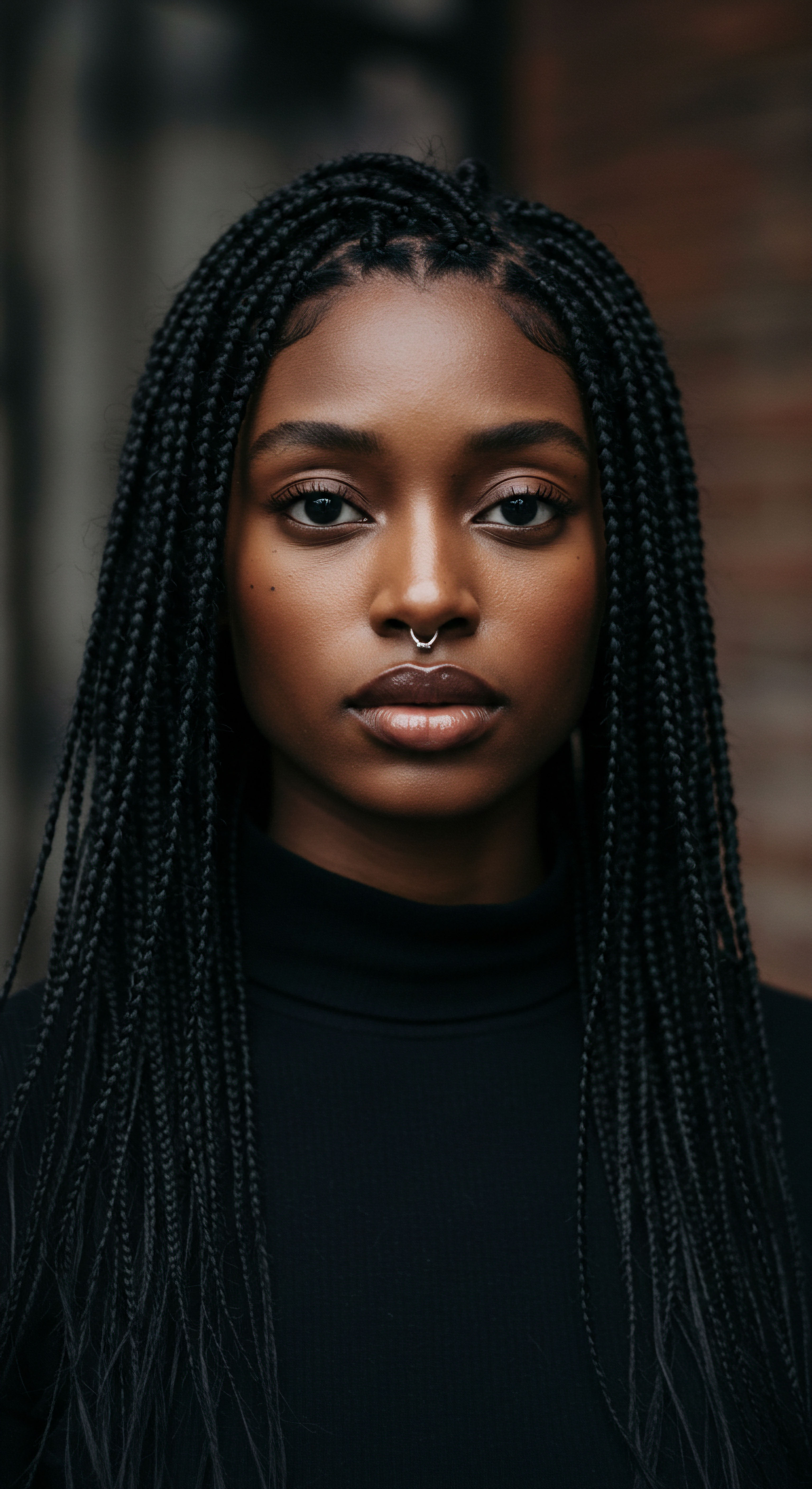
Reflection
As the soft glow of dawn touches the horizon, bringing with it the promise of a new day, we can appreciate the silent legacy of those who, through generations, guarded their textured hair as they slept. The historical tools and rituals were more than mere coverings; they were expressions of profound care, acts of resilience, and quiet celebrations of identity. They speak to an enduring wisdom, a gentle understanding of hair’s delicate nature, and the unwavering commitment to preserving its health and beauty. In these practices, we find not just answers to a historical question, but a timeless invitation to connect with our hair with the same reverence and thoughtfulness that our ancestors so gracefully embodied.

References
- Byrd, A. D. & Tharps, L. L. (2014). Hair Story ❉ Untangling the Roots of Black Hair in America. St. Martin’s Griffin.
- Robbins, C. R. (1994). Chemical and Physical Behavior of Human Hair (3rd ed.). Springer-Verlag.
- Rele, J. & Mohile, R. (2003). Hair cosmetics ❉ an overview. International Journal of Cosmetic Science, 25(3), 119-122.
- Wouters, G. J. J. et al. (2012). Surface friction of human hair. Journal of Cosmetic Science, 63(1), 1-10.
- Khumalo, N. P. et al. (2007). The morphology of African hair ❉ A scanning electron microscopic study. Journal of the American Academy of Dermatology, 57(3), 393-400.
- Mercier, A. A. (1930). Coefficient of Friction of Fabrics. Bureau of Standards Journal of Research, 5, 243–246.
- Omar, S. (2020). All About Afro ❉ unravelling the culture behind African hair braiding. Stylist.co.uk.
- Williams, M. (2021). How a Hair Wrap Routine Protects More Than Just My Hair. Sleep.com.
- Nickolson, N. & Petrov, J. (2020). From Rags, to Ringlets. Royal Alberta Museum.
- Rosado, S. (2003). The Grammar of Hair ❉ Hair, Culture, and Identity in Caribbean Women of African Descent. (Doctoral dissertation). University of Massachusetts Amherst.
- Abo-El-Khair, H. T. & Sayed, M. S. (2018). Friction Coefficient and Electric Static Charge of Head Scarf Textiles. Journal of Modern Engineering Science and Technology, 5(1), 1-10.
- Sallam, S. M. (2020). Friction Coefficient and Triboelectrification of Textiles. Journal of Modern Engineering Science and Technology, 7(1), 1-12.
- Patterson, A. L. & Okereke, O. (2024). Historical Perspectives on Hair Care and Common Styling Practices in Black Women. MDEdge.
- O’Connor, L. (2020). A Brief History Of Black Hair Rituals. ELLE.
- Nyela, O. (2021). Braided Archives ❉ Black hair as a site of diasporic transindividuation. (Master’s thesis). York University.